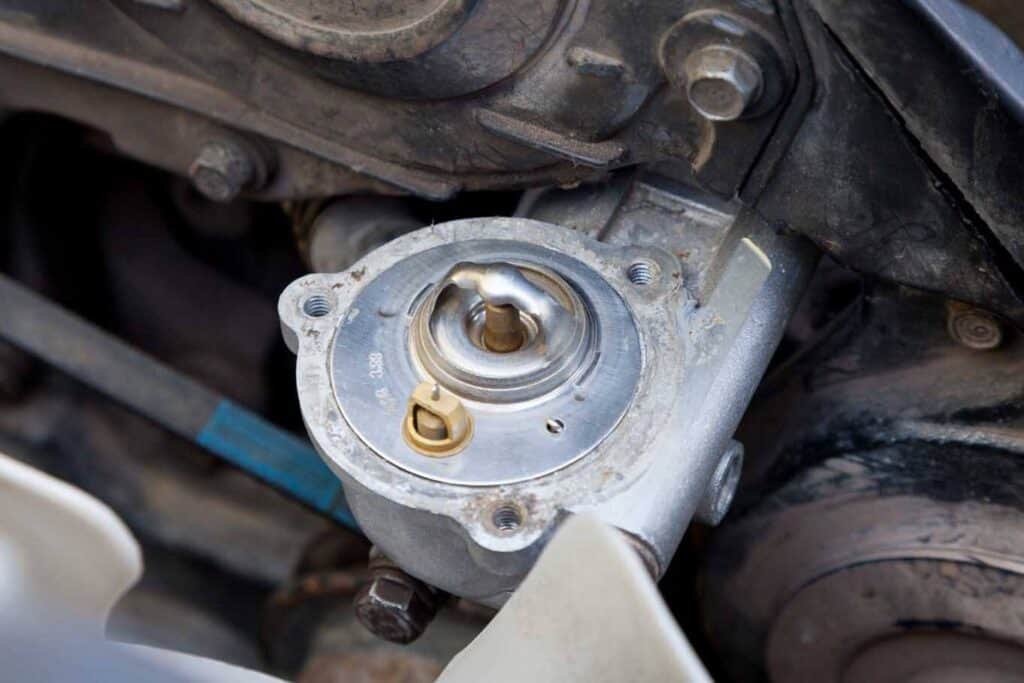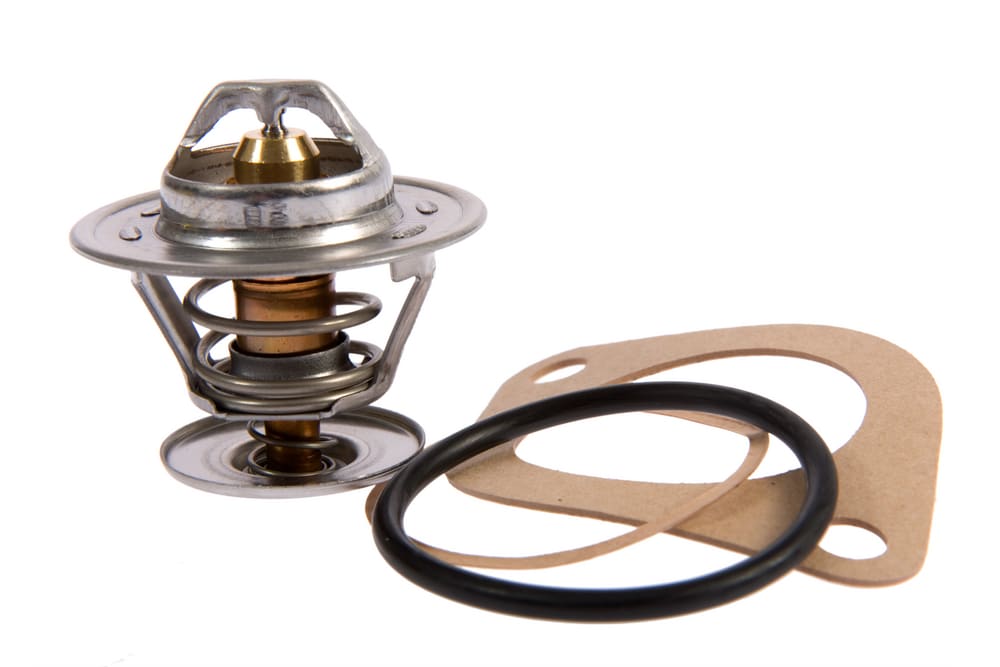A car’s thermostat is crucial for engine temperature control. It ensures the engine runs efficiently.
So, how long does a thermostat last in a car? Typically, a car thermostat can last around 10 years or 100,000 miles. The lifespan depends on driving conditions and maintenance. Regular checks can prevent unexpected failures. The thermostat regulates engine temperature by controlling coolant flow.
Over time, it can wear out or fail. Knowing its lifespan helps in planning maintenance. This can prevent overheating or engine damage. In this blog, we’ll explore the factors affecting thermostat life. You’ll learn signs of a failing thermostat and tips for maintenance. Understanding these can save you from costly repairs. Ready to dive in? Let’s get started!
Introduction To Car Thermostats
The thermostat in your car is a small but crucial part of the cooling system. It regulates the flow of coolant between the engine and the radiator. This helps the engine maintain an optimal temperature. Understanding its function and importance can help you take better care of your vehicle.
Function Of A Thermostat
The thermostat acts like a gatekeeper for the engine’s coolant. When the engine is cold, the thermostat stays closed. This allows the engine to warm up quickly. Once the engine reaches the right temperature, the thermostat opens. This lets the coolant flow to the radiator, preventing the engine from overheating. It’s a simple mechanism, but it plays a vital role in engine health.
Importance In Engine Performance
An efficient thermostat ensures the engine runs at the right temperature. This has several benefits:
- Prevents Overheating: Overheating can cause severe engine damage.
- Improves Fuel Efficiency: A well-regulated engine temperature leads to better fuel economy.
- Reduces Emissions: Proper temperature control helps the engine run cleaner.
A faulty thermostat can lead to poor engine performance. You might face issues like overheating or underheating. Both scenarios can reduce the engine’s lifespan. Regular checks and timely replacements can keep these problems at bay.
Typical Lifespan Of A Car Thermostat
The thermostat in your car is a small but essential component. It regulates the engine’s temperature. Knowing its typical lifespan can help you maintain your vehicle better. This section will explore the average lifespan and factors affecting it.
Average Lifespan
The average lifespan of a car thermostat is between 50,000 to 100,000 miles. Most last around 10 years. This varies based on driving conditions and maintenance.
| Driving Condition | Thermostat Lifespan |
|---|---|
| Normal | 10 years / 100,000 miles |
| Severe | 5-7 years / 50,000-70,000 miles |
Factors Affecting Lifespan
Several factors can affect the lifespan of a car thermostat. These include:
- Driving habits: Aggressive driving can shorten its life.
- Climate: Extreme temperatures can wear it out faster.
- Engine maintenance: Regular checks can extend its life.
- Coolant quality: Poor quality coolant can cause damage.
Understanding these factors helps in taking better care of your thermostat. Regular maintenance and good driving habits are key.
Signs Of A Failing Thermostat
Knowing the signs of a failing thermostat can prevent major engine issues. A faulty thermostat can cause severe damage if not addressed quickly. Below, we explore the key symptoms to look out for.
Overheating Engine
One of the most common signs of a failing thermostat is an overheating engine. If the thermostat stays closed, coolant cannot flow through the engine. This causes the temperature to rise rapidly. You might notice steam coming from under the hood. The temperature gauge might also show a high reading.
Erratic Temperature Gauge
An erratic temperature gauge is another indicator. The needle may move between hot and cold for no reason. This happens if the thermostat opens and closes irregularly. The engine may not maintain a consistent temperature. This can lead to poor performance and fuel efficiency.
Common Causes Of Thermostat Failure
Understanding the common causes of thermostat failure is crucial for maintaining your car’s health. Your car’s thermostat regulates engine temperature, ensuring it doesn’t overheat or cool down excessively. When it fails, the engine’s performance can suffer. Below are some frequent reasons behind thermostat failure.
Wear And Tear
Over time, all car parts endure wear and tear, and thermostats are no exception. The constant expansion and contraction due to temperature changes can cause the thermostat to weaken. This can lead to it getting stuck in an open or closed position.
When the thermostat is stuck open, the engine remains cool and doesn’t reach its optimal operating temperature. If it gets stuck closed, the engine overheats, leading to potential severe damage. Regular inspections can help detect wear and tear early.
Coolant Contamination
Coolant contamination is another common cause of thermostat failure. Contaminants in the coolant can clog the thermostat. This prevents it from opening and closing correctly. When coolant is not clean, it affects the thermostat’s ability to function properly.
Contaminants can come from rust, dirt, or debris within the cooling system. Using the right coolant and performing regular coolant changes can prevent contamination. A clean cooling system ensures the thermostat works efficiently.
| Cause of Failure | Effect |
|---|---|
| Wear and Tear | Thermostat gets stuck open or closed |
| Coolant Contamination | Clogs the thermostat, causing malfunction |
By understanding these common causes, you can take steps to prevent thermostat failure. Regular maintenance and inspections are key to keeping your car’s thermostat in good working condition.
Maintenance Tips For Extending Thermostat Life
Extending the life of your car’s thermostat is crucial. It ensures your engine runs smoothly and avoids overheating. Simple maintenance tasks can significantly prolong thermostat life. Here are key tips to keep your thermostat in good shape.
Regular Coolant Flushes
Flushing the coolant system regularly helps. Old coolant can become acidic. This can corrode the thermostat and other engine parts. Aim to flush your coolant every two years. It ensures that the system remains clean and free from debris. Fresh coolant helps maintain optimal engine temperature. This reduces strain on the thermostat.
Routine Engine Check-ups
Regular engine check-ups are essential. They help detect thermostat issues early. During these check-ups, mechanics inspect the cooling system. They ensure that all components are in good working order. Catching problems early can prevent major damage. This keeps your thermostat functioning longer. Schedule check-ups every six months. This simple step can save you from costly repairs down the line.

Credit: uchanics.ca
When To Replace Your Car Thermostat
A car thermostat usually lasts about 10 years. Signs like engine overheating or temperature gauge issues suggest it may need replacement. Regular checks can help maintain your car’s performance.
The car thermostat plays a key role in engine performance. It regulates the engine’s temperature. Knowing when to replace it can prevent many issues. Let’s explore some signs that indicate it’s time for a change.Mileage Considerations
A thermostat often lasts around 50,000 to 100,000 miles. Regular checks at each oil change can help. High mileage cars need more frequent inspections. Pay attention to your car’s service manual. It may suggest specific intervals for replacement.Visible Damage
Visible damage to the thermostat is a clear sign. Look for rust or corrosion. These can lead to malfunctions. Check for leaks around the housing. Cracks or broken parts signal an urgent need for replacement. Regular inspection helps spot these issues early. “`Diy Vs Professional Replacement
Deciding between DIY and professional thermostat replacement can be challenging. Each option has its advantages and disadvantages. Your choice depends on your skills, tools, and comfort level.
Pros And Cons Of Diy
DIY thermostat replacement can be cost-effective. You’ll only spend money on the thermostat itself. This option also gives you a sense of accomplishment. Learning new skills can be rewarding.
However, DIY projects come with risks. If you lack experience, you might make mistakes. These errors can cause further damage. You also need the right tools. Without them, the task becomes difficult. Safety is another concern. Mishandling car parts can lead to injuries.
When To Seek Professional Help
Professional help ensures the job is done correctly. Mechanics have experience and the right tools. They can identify and fix related issues. This option saves time. Professionals complete the task faster than most DIY enthusiasts.
Professional replacement is more expensive. You pay for parts and labor. But the peace of mind is worth the extra cost. If you’re unsure about your skills, it’s best to seek help. This choice prevents mistakes and ensures your car runs smoothly.

Credit: www.yourmechanic.com
Cost Of Thermostat Replacement
Replacing a car thermostat is crucial for engine health. Understanding the cost involved helps in budgeting for this essential maintenance. Here, we break down the costs associated with thermostat replacement.
Parts And Labor Costs
The cost of replacing a thermostat varies. The main factors are parts and labor.
Parts Costs: The thermostat itself is not very expensive. It usually ranges from $20 to $50. The cost depends on the car model and brand.
Labor Costs: Labor costs can vary significantly. On average, expect to pay between $100 and $200. The labor cost depends on the complexity of the job and the mechanic’s rate.
| Type | Cost Range |
|---|---|
| Parts | $20 – $50 |
| Labor | $100 – $200 |
Ways To Save Money
There are several ways to save money on thermostat replacement.
- Do It Yourself: If you have basic mechanical skills, you can replace the thermostat yourself. This saves labor costs.
- Buy Parts Online: Online stores often offer parts at lower prices. Always check for deals and discounts.
- Look for Coupons: Many auto repair shops offer coupons. Use them to reduce labor costs.
- Regular Maintenance: Regularly maintain your vehicle. This prevents major issues and saves money in the long run.
Remember, a well-maintained thermostat ensures your engine runs smoothly. Regular checks and timely replacement can save you from costly repairs.

Credit: www.dubizzle.com
Frequently Asked Questions
How Long Does A Car Thermostat Typically Last?
A car thermostat usually lasts about 10 years. It can vary based on usage and maintenance.
What Are The Signs Of A Failing Car Thermostat?
Signs include engine overheating, erratic temperature readings, and poor heater performance. Watch for these issues.
Can A Bad Thermostat Affect Car Performance?
Yes, a bad thermostat can cause overheating or poor engine performance. It’s important to address it quickly.
How Often Should You Replace A Car Thermostat?
Replace your car thermostat every 10 years or as needed. Regular checks can prevent problems.
What Happens If You Don’t Replace A Bad Thermostat?
Ignoring a bad thermostat can lead to engine damage. It’s crucial to replace it to avoid costly repairs.
Conclusion
A car’s thermostat generally lasts about 10 years. Regular maintenance helps extend its life. Watch for signs of failure, like overheating or temperature fluctuations. Replace the thermostat if issues arise. This ensures your engine runs smoothly. Regular checks save you from costly repairs.
Keep your car in top shape. Your vehicle will thank you.
